A Miracle in Milk Country: Rediscovering One of Colombia's Rarest Birds
Rodolfo Correa Peña is an affable young Colombian living in the town of San Pedro de los Milagros, in the green hills outside of Medellín in northwestern Colombia. This deeply traditional religious community is by and large devoted to dairy production and the surrounding countryside reflects this. But here and there in the Colombian department of Antioquia sit strips of natural habitat. It turns out some are home to one of the rarest of birds, which shares the department's name.
It takes maybe fifteen minutes to walk out of town from the main square or plaza, with its tall, beautiful church and surrounding bustling shops. But people joke that it takes Rodolfo far longer. That's because he knows everyone and they stop him to talk along the way. With a dark beard and charismatic smile, Rodolfo almost has the look of a revolutionary – and it just may turn out that he revolutionizes bird conservation around his hometown in the future.
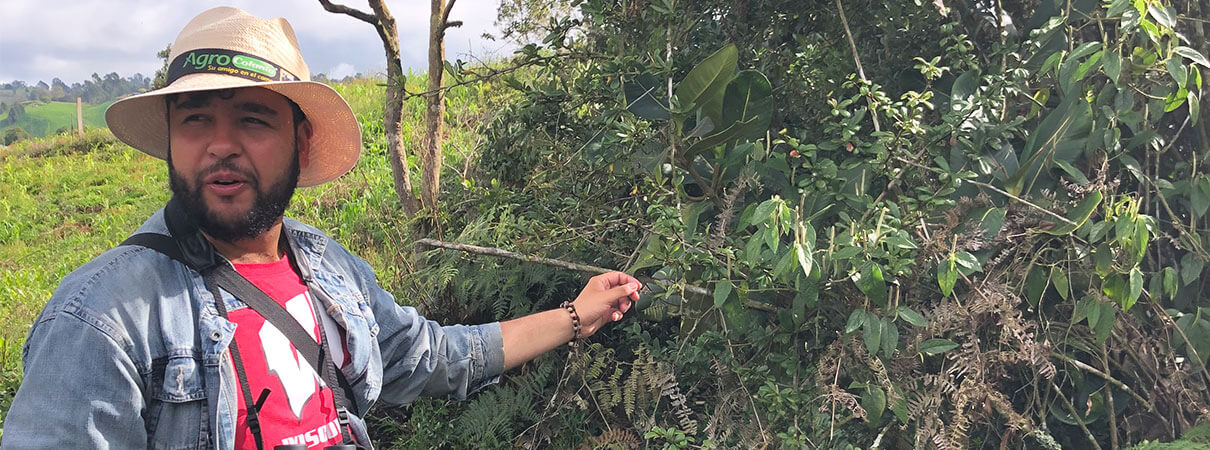
Rodolfo Correa Peña is a charismatic local ambassador for the Antioquia Brushfinch, and the first to recognize it in the wild. Photo by Dan Lebbin.
Rodolfo has always been interested in nature, but he only recently became hooked on birding after participating in and being inspired by eBird's Global Big Day in May 2017. At the time of our visit, Rodolfo was studying to become an agronomy engineer at the National University of Colombia in Medellín as part of the Conservation and Management of Agroecosystems research group (CyMA). A quick study, he pored over his field guide and other materials and learned his local birds and their sounds. Just months later, he made ornithological history.
On January 7, 2018, Rodolfo was walking to town for Sunday mass, when he saw a rusty-crowned songbird cross the road. Rodolfo opened his phone's bird guide app. The best match: the Antioquia Brushfinch, labeled as probably extinct. Rodolfo shared his sighting, which triggered a series of searches to document the bird's continued survival, and kick-started conservation efforts to help it.
The Antioquia Brushfinch is a large, chunky sparrow, with grayish plumage and a boldly marked head pattern characterized by a rusty crown, contrasting a black mask around the eyes and a milky white throat and faint moustachial stripe. It looks a lot like the widespread Slaty Brushfinch, and was initially confused with this species. The Slaty, however, has a darker moustachial stripe, a white square-shaped marking on its wings, and white lores (the area between bill and eye).
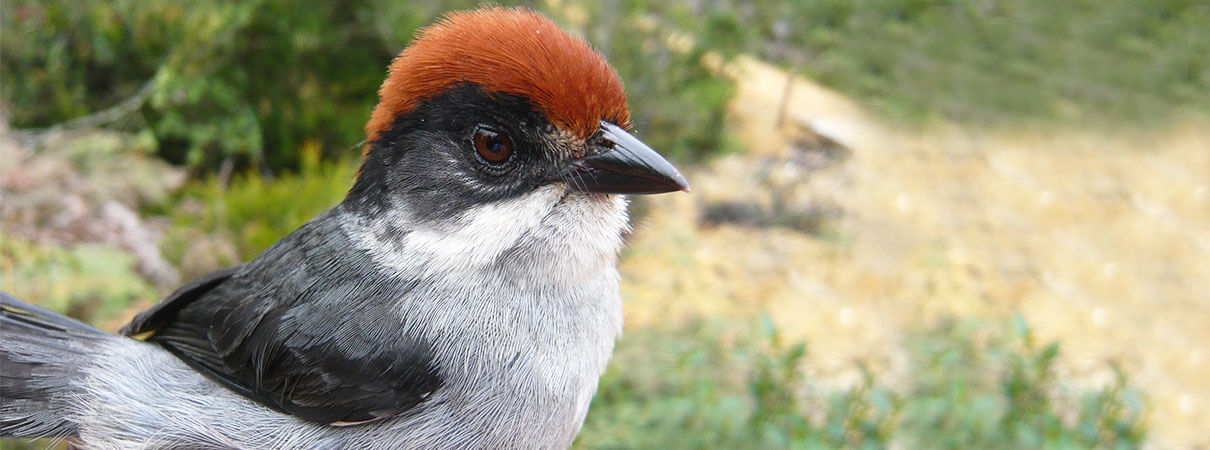
Antioquia Brushfinch. Photo by Sergio Chaparro-Herrera.
Thomas Donegan first described the Antioquia Brushfinch in 2007 after a review of museum specimens of Colombian brushfinches revealed three specimens labeled from the town of San Pedro de los Milagros (Saint Peter of Miracles) and “Antioquia” generally. These were labeled as representing an undescribed subspecies of the Slaty Brushfinch. Two of these specimens were undated, and one was collected in 1971. They were not in fact Slaty Brushfinches, but a new species. Several searches failed to re-find this bird after it was recognized as distinct, and most authorities feared it extinct. Maybe a miracle was needed to relocate this lost species, and maybe such a feat was more likely near a town named for miracles.
Shortly after his first sighting, Rodolfo got better photos of the birds he saw and, hoping to confirm his identification, he sent them to Juan Luis Parra, a professor at the University of Antioquia. These photos were passed on to Sergio Chaparro-Herrera, who had dreamed of re-finding this bird, had previously searched for it unsuccessfully, and had authored an account of the species in the red book of threatened birds in Colombia. At the time, he was across the Andes in the capital city of Bogotá. He immediately recognized the photos as the missing Antioquia Brushfinch and headed out to meet Rodolfo to confirm the bird's survival in person. This first meeting also launched an effort by Sergio to locate additional brushfinches, identify remnant pockets of habitat occupied by the bird, and learn as much as possible about it.
Initial field work in early 2018 by Sergio, Rodolfo, Andrea Lopera, and J. L. Parra found up to 12 birds in three patches of habitat. In July, Sergio applied for a Skutch Research Award from the Association of Field Ornithologists to study the brushfinch's nesting behavior and investigate if nest parasitism by Shiny Cowbirds was a threat to the species.
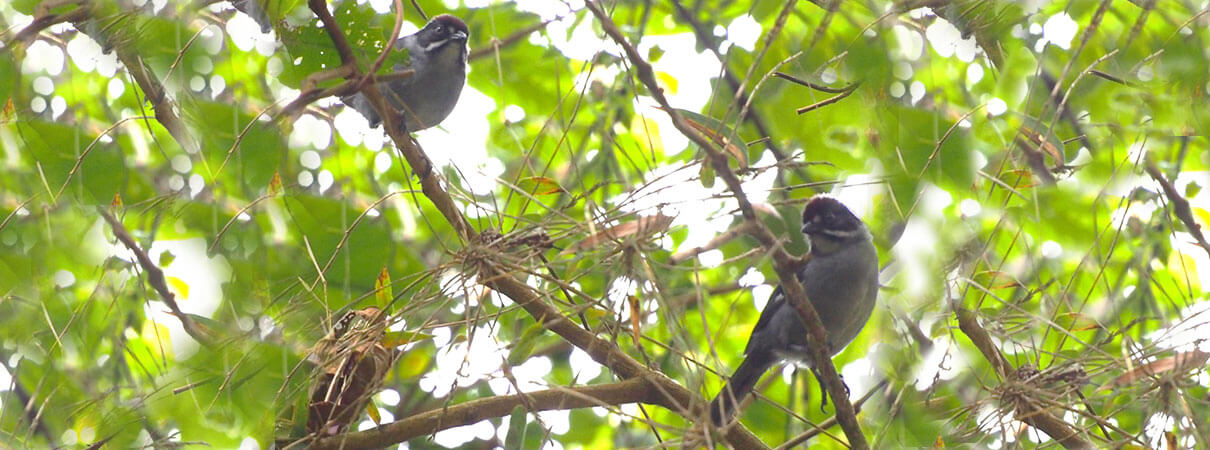
The Slaty Brushfinch shows a darker moustachial stripe, darker gray underparts, and white wing speculum – features that distinguish it from the Antioquia Brushfinch. Photo by Dan Lebbin.
As a reviewer for Skutch Research Awards, I was shocked to see a proposal, complete with photos and maps, focused on this lost bird. At that point, the rediscovery had not been made public. Earlier in the year, on a trip through Medellín with American Bird Conservancy (ABC) President Mike Parr, the two of us had discussed taking an afternoon to search for the brushfinch, unaware that it was already re-found. We never made our search, thanks to a delayed flight departure. After the award committee granted Sergio funding in August, I contacted him directly to discuss the need for additional searches and conservation steps. By October, ABC was supporting Sergio's research team to search for additional habitat patches occupied by Antioquia Brushfinches and to begin planning actions to help this bird. With this additional support, the team has already found a fourth occupied habitat patch with additional birds. Even with all this effort, the total known population near San Pedro de los Milagros does not exceed 20 birds.
In November 2018, Wendy Willis, ABC's Deputy Director of International Programs, and I traveled to Medellín and arranged a visit with Sergio and Rodolfo. We wanted to meet them in person, and see where the brushfinch was re-found. We brought along Jhon Jairo Lopera Marín, a specialist in sustainable cattle ranching with the nonprofit Centro para la Investigación en Sistemas Sostenibles de Producción Agropecuaria (CIPAV). ABC had previously worked with CIPAV in Colombia to pilot and promote techniques to restore trees to pastures, thereby providing forest bird habitat in working landscapes used for cattle production. We suspected that such silvopasture techniques might offer opportunities for restoring brushfinch habitat in the dairy-producing region of San Pedro de los Milagros. After an early departure from downtown Medellín, Wendy, Jhon, and I arrived at San Pedro de los Milagros, met up with Sergio and Rodolfo, and soon found ourselves searching one of the first patches where the brushfinch had been rediscovered.
We walked dirt paths along the edge of remnant scrubby habitat bordered by freshly tilled fields of bare black soil, planted parcels of corn and beans, and open pastures with dairy cattle quietly grazing. Sergio and Rodolfo scanned the edge in different directions. All of a sudden, Sergio signaled that the bird was there – not just one but three or four Antioquia Brushfinches traveling in a family group.
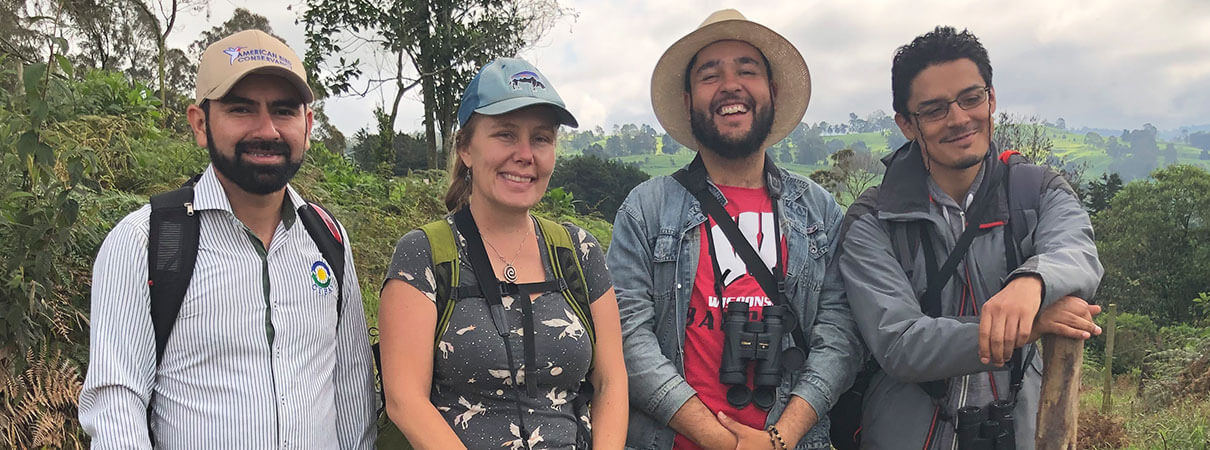
Left to right: Jhon Jairo, Wendy Willis, Rodolfo Correa Peña, and Sergio Chaparro-Herrera. Photo by Dan Lebbin.
And, just like that, all of us had clear views of nearby Antioquia Brushfinches. As the birds hopped along the edge of spindly trees and dense bushes, we soaked in the realization that, at that moment in time, just ten people had ever seen these birds in the wild. (According to Sergio's estimation, I, Wendy, and Jhon were numbers eight, nine, and ten.) The birds went about their business, seemingly unconcerned about the people admiring them from beyond the brush. Eventually they passed out of view, and we all celebrated.
This celebration was just another beginning, as we all knew much more work lay ahead. As dire as the conservation status for the Antioquia Brushfinch may appear, this species can be saved. ABC's Ecuadorian partner Fundación Jocotoco has proven this with a similar species – the Pale-headed Brushfinch.
The Pale-headed Brushfinch was feared extinct and then rediscovered in 1998. At the time of rediscovery, five to 15 pairs were thought to survive. ABC helped Fundación Jocotoco purchase eight tracts of land to establish and then expand the Yunguilla Reserve to protect this brushfinch's last refuge, between 2004 and 2014. The reserve now totals 484 acres. Habitat restoration and control of parasitic cowbirds was implemented by Fundación Jocotoco, and the brushfinch population increased to 200 individuals by 2008. In 2014, IUCN (the International Union for Conservation of Nature) down-listed this species from Critically Endangered to Endangered. Now, birders routinely visit Yunguilla Reserve and see the Pale-headed Brushfinch in the field or visiting a feeding station. The Pale-headed Brushfinch population continues to grow beyond the reserve's borders, and additional land acquisitions to expand the reserve are now being considered.
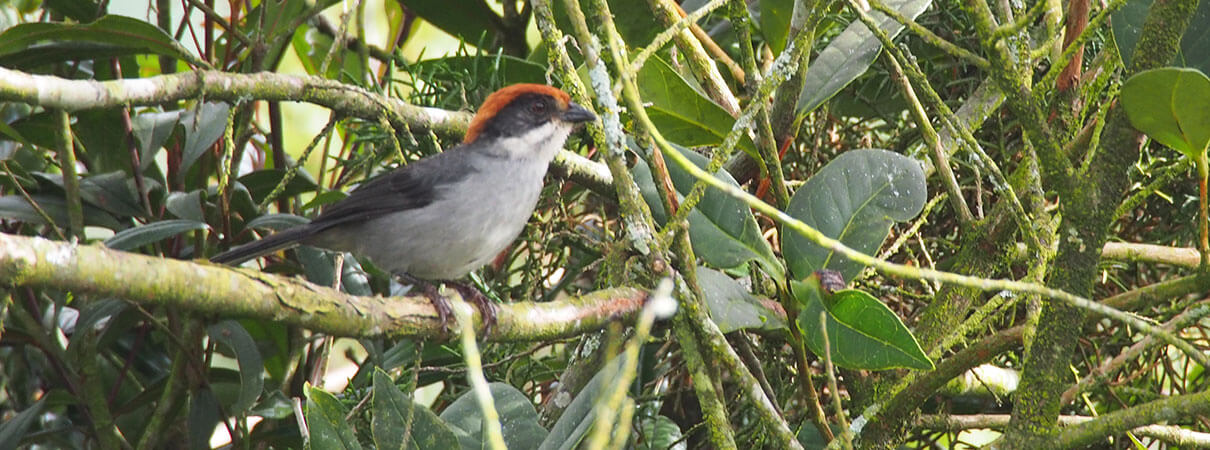
The Antioquia Brushfinch is identified by the absence of white speculum in wing, faint moustachial stripe, and lack of white spot in lore — all fieldmarks that distinguish it from the Slaty Brushfinch. Photo by Dan Lebbin.
With hard work starting now, it is possible that we could write a success story for the Antioquia Brushfinch. Perhaps 15 years from now, it will read as well as that of the Pale-headed Brushfinch. This species has persisted until now in close proximity to people, does not appear to require pristine forest, and it is possible that suitable habitat can be quickly restored, even on working cattle ranches. Perhaps feeding stations will be set up in the near future to attract brushfinches that will, in turn, draw visiting birders, tourists, and locals. People might then be able to enjoy views of one of Colombia's rarest birds as part of larger tourism circuits including dairy farms and birding sites near one of Colombia's largest cities. And maybe local cattle ranching methods will shift from current practices heavily dependent on expensive pesticides to more organic and bird-friendly practices that include trees and other plants within pastures that can support brushfinches.
Rodolfo, Sergio, and their colleagues have now published the rediscovery of the Antioquia Brushfinch in the journal Cotinga. The world now knows the bird survives, and it is certainly time for action: Since the day we visited, much of the habitat where we first laid eyes on the brushfinches was cleared for bean and corn production, but the species has been found at two additional sites north of San Pedro de los Milagros.
ABC is working hard with Sergio's team to plan and implement actions to help the Antioquia Brushfinch, including much-needed land protection, habitat restoration, and additional searches.
 | Daniel Lebbin is the Vice President of Threatened Species at American Bird Conservancy. He completed his Ph.D. dissertation at Cornell University in 2007 on habitat specialization of Amazonian birds. |


















































